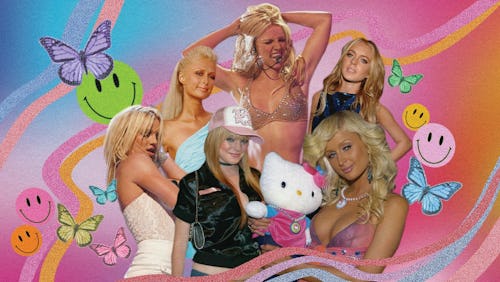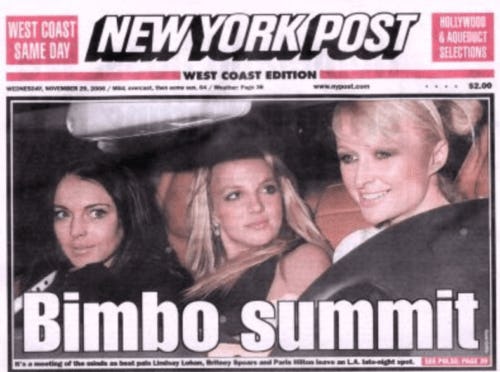
In 2006, the New York Post ran a front-page photo featuring three of the most famous women in modern history: Britney Spears, Paris Hilton, and Lindsay Lohan. In the Post’s signature headline style, bold white lettering succinctly summed up the lives of the women who were captured by paparazzi in the front seat of a car, fleeing a party: BIMBO SUMMIT.
In the original article, the Post calls the women the “three bimbos of the apocalypse.” “Bimbo” was used with vitriol at the time to point out that Spears was a bad mom who favored parties over her children and Lohan would take any opportunity to purposefully flash her lady bits for the paparazzi.
A few months after a memorable night out, the Post published an article about a survey of 1,000 American adults in which 77% believed that “the panties-optional trio of Paris Hilton, Britney Spears, and Lindsay Lohan has too much influence on young girls.” (The Post’s title: “Banish the Bimbos to Limbo.”)
If you’ve ever spent a moment on Tumblr, Twitter, TikTok, or any social media platform from the past 10 years, you probably can recall the “bimbo summit” without me showing it to you. It’s an iconic cover and a cultural relic of the mid-2000s, a time when the bimbo captured the attention of America: seemingly stupid, vain, and rich women, acting irresponsibly without a care in the world.

A year later, we saw the global economy collapse under the pressure of predatory and overleveraged housing loans, proselytized by Wall Street bros. The men who caused this financial crisis lacked foresight, care, and most importantly, empathy. Rising out of the suds of the housing bubble came a cleaner, more empathetic, hyper-capitalist superheroine who claimed her sensitive, feminine touch could save the economy and ultimately the world: the Girlboss.
The Girlboss would replace the Bimbo in the zeitgeist of American pop womanhood for the next decade. She claimed to be everything the bimbo wasn’t: driven, responsible, and ambitious. She was sexy but not slutty, friendly but not approachable. She would come to dominate pop culture, social media, corporate conference rooms, and elitist private social clubs.
The cutesy term was brought into the popular lexicon largely by Sophia Amoruso, founder of one of the first fast-fashion e-commerce giants, Nasty Gal. In 2015, Amoruso published an autobiography of her rise to #girlboss success, where she tells the epic tale of bootstrapping her eBay fashion business until it grew into a pair of 6-inch stilettos — all thanks to her cleverness and willingness to work hard. Amoruso's approach to business was formulaic, she preached, and could be replicated by any other woman looking to achieve the same success.
The girlboss movement resonated with mostly white women whose oppression was limited to the corporate offices where they already worked. Nonetheless, the girlboss falsely believed her J. Crew-clad femininity could turn the cruel hand of free-market into a manicured empathy machine that worked for everyone. While potentially borne out of good intentions, the girlboss was distracted by her own vacuous potency. She simply couldn’t revamp capitalism and finally had to admit defeat in the face of increasing structural inequality, rising inflation, and collapsing social safety nets, particularly so as the world economy collapsed once again in the face of a global pandemic.
In response to her rather public demise, a new critique of the super-capitalist white barbie was born, reclaiming a historically derogatory word to self-identify. The bimbo is back.
The girlboss claimed to be everything the bimbo wasn’t: driven, responsible, ambitious.
In the original “bimbo summit” article, the Post wrote that Britney, Paris, and Lindsay were marked by their “spectacularly bad choices” and flaunting “no clue, no cares, and no underwear.” It’s a lifestyle that I and many of my friends stand strongly behind today.
I, too, self-identify as a bimbo and host my own bimbo summit bi-annually with my best bimbo friends. We share little bimbo tattoos and act recklessly, alá bimbo Jackass. We all consistently have badly bruised knees from our terribly planned stunts, and share hideous photos of one another in our worst moments via a private Instagram account that might get any of us fired from our jobs.
The bits run deep and are simply not to be explained, as is a core bimbo rule. I was recently asked by a Hinge suitor what I meant by the word, and I quickly responded with my own definition: A bimbo is a smart idiot who loves doing stupid but highly intelligent bullshit. Bimbo has no gender and can be assumed by anyone willing to take on the responsibility of the role.
One of TikTok’s most famous self-proclaimed bimbos, 21-year old Chrissy Chlapecka, boasts 3.8 million followers. Her rise to bimbo stardom started with a viral question that critiqued the world economy in one fell swoop: “I don’t care what you say to me, I still don’t understand why we can’t just print more money?” Chrissy is well aware of the concept of inflation, but she posits that “nothing is real,” and if we all just collectively agreed that the government is lying to us, can’t we simply agree that inflation is made up too?
Chrissy is hyperfeminine in her videos; she’s gorgeous, blonde, busty, and loves the color pink. As a trend forecaster by trade, I can’t forego this opportunity to talk about how the bimbo movement has also evolved into an aesthetic trend. Baby pink, feather trims, velour, and diamond embellishments have all been revived, and 2000s retailers and brands like Bebe, Juicy Couture, Miss Sixty, Rampage, and Wet Seal are popular on resale sites like Depop. New iterations oftentimes include Hollister and Abercrombie & Fitch, lumping together Y2K aesthetics, though historically these brands had little associations with the bimbo culture of the time. Still, it’s all a far cry from the corporate-led business casualwear of the girlboss.
Lacking a drive for traditional education, Chrissy was labeled a bimbo in her childhood by teachers and peers alike. But it wasn’t until 2020 that she embraced the term and began her BimboTok journey. I asked Chrissy recently about how she captured the bimbo zeitgeist. “I was on TikTok saying and doing these stupid things, but also it’s smart,” she told me. “Capitalism is actually really fucking bad — this shit doesn’t make any sense. So why are we doing it?”
Chrissy cynically points out that men are allowed the space to literally ruin the planet while women are expected to uphold intellectual sanctity. “Why do we uplift men when they are dumbasses? Jeff Bezos, supposedly one of the smartest people in the world, spent all kinds of money to go to space for three minutes and be like ‘hey!’ [She coyly throws up a peace sign and sticks out her tongue], and then came back down. Um, sir, you could have literally solved world hunger, you fucking dumbass.”
This critique goes for women too, and Chrissy is fed up with the good-natured bimbo being put down. “The women that we should be putting down are the women who are being racist and being bad horrible people. Those are the stupid ones, those are the ones we should be putting down.”
Bimbos like Chrissy, hardly old enough to remember the 2007 bimbo summit, feel a special connection to the image that Paris, Britney, and Lindsay created — that senseless fun and sexualized idiocracy is actually perfectly acceptable. Being a bimbo, in fact, rules.
A bimbo is a smart idiot who loves doing stupid but highly intelligent bullshit.
Paris, Britney, and Lindsay may not have consciously known how their nights of drug use and alcohol abuse would change a nation. But more than a decade later, they’re now far more aware of their personas and often use bimbonomics to their favor. Paris Hilton’s new show on Netflix is a prime example. Cooking with Paris uses the bimbo aesthetic that she made famous in her 20s; in Paris’s kitchen, glitter, designer labels, and glamour far outweigh flavor. The food better suits a child’s palate than the adults she’s cooking for. The vast majority of the outfits Paris wears pose a fire hazard, and her couture is often ruined by the food — a clever nod to the “airhead” qualities of the bimbo. In Cooking with Paris, she dramatizes the girlbossery she was supposed to have aspired to in her career — and recognizes that her bimbo persona is what made her successful.
Britney Spears’s conservatorship battle is also at the crux of bimbo reclamation. It is no longer acceptable to society that Britney’s golden years of partying and frivolity were enough to strip her of her legal rights as an adult woman. Despite her ability to perform for thousands of people and keep the machine running on her celebrity empire, Britney was denied access to her own money and her own reproductive capacity. The team surrounding her, consisting of mostly male lawyers, judges, doctors, and of course, her own father, weaponized her bimbo behavior and mental health issues to justify her civil death. The movement to give Britney her freedom back ultimately pointed to the absurdity of the conservatorship. (Britney’s father, Jamie Spears, was removed as her conservator in late September.)
In the 2000s, society was extremely worried about the influence these women would have on young girls. But the women of the bimbo summit are some of the most successful businesswomen of our era, and they have started social movements that will have a lasting impact on young girls and society at large. Paris has turned her bimbo aesthetics and talents into a multi-billion dollar empire. Britney has sparked a social movement that will change the way we look at conservatorships forever. Lindsay has made us consciously consider the repercussions of child stardom and growing up in the spotlight, and opened the conversation on mental health and substance abuse.
Being a bimbo is being allowed to act irresponsibly, sexually, and even stupidly without the punishment of men or the judgmental eyes of other women. A modern bimbo has no specific physical traits, IQ, or gender, but rather, is a collective mindset that leaves women free to do as they please — that is, until the free market destroys us all.







